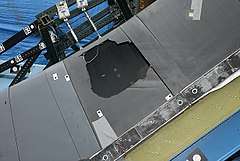Reinforced carbon–carbon
Carbon fibre reinforced carbon[n 1] (CFRC[4]), carbon–carbon (C/C[2]), or reinforced carbon–carbon (RCC) is a composite material consisting of carbon fiber reinforcement in a matrix of graphite. It was developed for the reentry vehicles of intercontinental ballistic missiles, and is most widely known as the material for the nose cone and wing leading edges of the Space Shuttle orbiter. Carbon-carbon brake discs and brake pads have been the standard component of the brake systems of Formula One racing cars since 1976.

Carbon–carbon is well-suited to structural applications at high temperatures, or where thermal shock resistance and/or a low coefficient of thermal expansion is needed. While it is less brittle than many other ceramics, it lacks impact resistance; Space Shuttle Columbia was destroyed during atmospheric re-entry after one of its RCC panels was broken by the impact of a piece of foam insulation from the Space Shuttle External Tank.
Production
The material is made in three stages:[5]
First, material is laid up in its intended final shape, with carbon filament and/or cloth surrounded by an organic binder such as plastic or pitch. Often, coke or some other fine carbon aggregate is added to the binder mixture.
Second, the lay-up is heated, so that pyrolysis transforms the binder to relatively pure carbon. The binder loses volume in the process, causing voids to form; the addition of aggregate reduces this problem, but does not eliminate it.
Third, the voids are gradually filled by forcing a carbon-forming gas such as acetylene through the material at a high temperature, over the course of several days. This long heat treatment process also allows the carbon to form into larger graphite crystals, and is the major reason for the material's high cost. The gray "Reinforced Carbon–Carbon (RCC)" panels on the space shuttle's wing leading edges and nose cone cost NASA $100,000/sq ft to produce, although much of this cost was a result of the advanced geometry and research costs associated with the panels. This stage can also include manufacturing of the finished product.[5]
C/C is a hard material that can be made highly resistant to thermal expansion, temperature gradients, and thermal cycling, depending on how the fibre scaffold is laid up and the quality/density of the matrix filler.
Mechanical properties
The strength of carbon–carbon with unidirectional reinforcement fibres is up to 700 MPa. Carbon–carbon materials retain their properties above 2000 °C. This temperature may be exceeded with the help of protective coatings to prevent oxidation.[6] The material has a density between 1.6–1.98 g/cm3.[7]
Similar products
Carbon fibre-reinforced silicon carbide (C/SiC) is a development of pure carbon–carbon, and can be used in automotive applications, such as components of brake systems on high performance road cars, namely the brake disc and brake pads. C/SiC utilises silicon carbide with carbon fibre, and this compound is thought to be more durable than pure carbon-carbon. However, it is heavier and hence not used in Formula 1 racing.
Applications initially included the Mercedes-Benz C215 Coupe F1 edition,[8] and are standard fitment on the Bugatti Veyron and certain current Bentleys, Ferraris, Porsches, Corvette ZR1, ZO6 and Lamborghinis. They are also offered as an "optional upgrade" on certain high performance Audi cars, including the D3 S8, B7 RS4, C6 S6 and RS6, and the R8.
Carbon brakes became widely available for commercial airplanes in the 1980s[9] having been first used on the Concorde supersonic transport.
A related non-ceramic carbon composite with uses in high tech racing automotives is the carbotanium carbon–titanium composite used in the Zonda R and Huayra supercars made by the Italian motorcar company Pagani.
Footnotes
- Variously hyphenated "carbon fibre reinforced carbon",[2] "carbon-fibre-reinforced carbon",[3] or "carbon fibre-reinforced carbon";[4] while "carbon fibre" is also spelled "carbon fiber".
References
- On the Leading Edge
- Kochendörfer, Richard (2009-09-28) [2001]. Singh, Mrityunjay; Jessen, Todd (eds.). "Ceramic Matrix Composites - From Space to Earth: The Move from Prototype to Serial Production". Ceramic Engineering and Science Proceedings. John Wiley & Sons. 22 (3: 25th Annual Conference on Composites, Advanced Ceramics, Materials, and Structures — A): 11–22 : 11. doi:10.1002/9780470294680.ch2. ISBN 9780470295144. ISSN 0196-6219. Retrieved 7 September 2017.
- Fritz, W.; Hüttner, W.; Hartwig, G. (2012-12-06) [1979]. "Carbon-Fibre-Reinforced Carbon Composites: Processing, Room Temperature Properties, and Expansion Behaviour at Low Temperatures". In Clark, A. F.; Reed, Richard; Hartwig, Gunther (eds.). Nonmetallic Materials and Composites at Low Temperatures. Cryogenic Materials (CRYMS). Springer Science & Business Media. pp. 245–266 : 245. doi:10.1007/978-1-4615-7522-1_16. ISBN 9781461575221. Retrieved 7 September 2017.
- Lewandowska-Szumieł, M; Komender, J; Gorecki, A; Kowalski, M (1997). "Fixation of carbon fibre-reinforced carbon composite implanted into bone". Journal of Materials Science: Materials in Medicine. 8 (8): 485–488. doi:10.1023/A:1018526226382. ISSN 0957-4530.
- "Carbon Fiber Properties" (PDF). Rochester Institute of Technology EDGE (Engineering Design Guide and Environment). May 2004. Retrieved January 30, 2019.
- Material Properties Data: Carbon–carbon
- LALIT M MANOCHA (24 April 2003). "High performance carbon–carbon composites" (PDF). Sadhana. 28: 349–358. Retrieved 2014-06-28.
- 2000 Mercedes-Benz CL55 AMG F1
- Boeing: Operational Advantages of Carbon Brakes